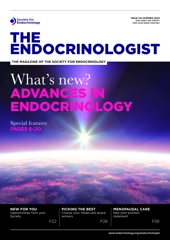In the quest to improve glycaemic management, advances in wearable technology have transformed care for people with type 1 diabetes (PWD) and healthcare professionals (HCPs). The management of type 1 diabetes intrinsically involves regular glucose monitoring, appropriate insulin dosing and balancing the burden of hypo- and hyperglycaemia, with an eventual aim of reducing the risk of long term complications. Interpretation of the data generated has offered new perspectives to PWD and HCPs in management of the disease and making therapeutic decisions.
Healthcare policy and clinical guidance have aligned with contemporary research outcomes to allow wider and regular uptake of technology for type 1 diabetes care in the NHS. Outcomes thus far have shown significant improvements in glycaemic markers, hospitalisation rates and quality of life across the age spectrum.
CLOSED LOOP SYSTEMS: THE ‘NEW KID ON THE BLOCK’

Closed loop systems have revolutionised the management of type 1 diabetes in patients. Credit: Shutterstock
Continuous glucose monitoring (CGM) is of two types: real time (rtCGM) or intermittently scanned (isCGM). rtCGM systems (Dexcom, Medtronic, Medtrum) measure glucose every few minutes and actively transmit data wirelessly from the sensor to a reader or smartphone app, whereas isCGM systems (FreeStyle Libre) transmit data only when the user scans their sensor with a reader or smartphone app.
The development of closed loop systems, which link rtCGM to various insulin pumps and automatically adjust insulin delivery via an algorithm, have revolutionised the management of type 1 diabetes in patients. Four hybrid closed loop systems are currently available and licensed for use in PWD, with various minimum ages for use. These systems are: the 670G hybrid closed loop (HCL) system and 780G advanced HCL (Medtronic, Northridge, CA, USA), the CamAPS FX interoperable app (CamDiab, Cambridge, UK), and the Control IQ system (Tandem Inc., San Diego, CA, USA). Clinical trials show that hybrid closed loop insulin delivery is safe and improves glycaemic outcomes in PWD.
TIME IN RANGE: MOVING ON FROM HbA1c
Glycated haemoglobin (HbA1c) has been a widely available measure of glycaemic management and considered a ‘gold standard’ in assessing the risk of complications. Amongst the many limitations, it does not give an accurate indication of day-to-day variability of glucose levels, which effects the overall well-being of PWD.
A plethora of data are generated from rtCGM and isCGM for standardised analysis, endorsed by international consensus, which gives highly valuable information. Amongst them, the proportion of the time a PWD spends each day in a defined target range constitutes the concept of ‘time in range’ or %TIR (3.9–10.0mmol/l). This measure is responsive to changes in diet and aspects of lifestyle, to aid in therapeutic decision making for PWD and HCPs.
'Healthcare policy and clinical guidance have aligned with contemporary research outcomes to allow wider and regular uptake of technology for type 1 diabetes care in the NHS.'
In addition, the International Consensus on Time in Range has defined clear targets for PWD, women with type 1 diabetes in pregnancy, older individuals and those with hypoglycaemia unawareness. Furthermore, extrapolation of data from 1440 Diabetes Control and Complications Trial participants and reanalysis has shown a 40% reduction in microalbuminuria and a 64% reduction in retinopathy for every 10% increase in %TIR.
CHALLENGES IN TECHNOLOGY UPTAKE
In recent years, there has been encouraging progress in the uptake of technology in the UK. This has been boosted by the national rollout of FreeStyle Libre, successful procurement of all commercially available insulin pump systems and changes to NICE guidance on CGM for type 1 diabetes in pregnancy, resulting in a third of individuals with type 1 diabetes using CGM.
Within this progress lies obvious challenges. Similar to trends in healthcare access, uptake of technology in type 1 diabetes also witnesses inequalities amongst different populations and indices of socioeconomic deprivation. A conspicuous drop in usage during adolescence and young adulthood due to alarm burnout and peer pressure, amongst other factors, adds further challenges during transition from paediatric to adult diabetes care. Additionally, regional organisational and service delivery barriers can further restrict the widespread use in an eligible population.
WHAT THE FUTURE HOLDS
The landscape of technology in type 1 diabetes care is changing at an unprecedented pace. More sophisticated commercial systems are being developed by industry and being rolled out early as a result of the success seen in recent years.
Radical changes to the NICE eligibility criteria in 2022 will result in wider availability of CGM to all individuals with type 1 diabetes. The ongoing real world HCL trial in England will further shed light on its effectiveness across children, young people and adults, with results expected towards the end of 2022.
The aim to reduce inequalities in uptake remains at the forefront of current policy and transformational plans within NHS England. However, individualised care, support and education, with clinical leadership, remain the most powerful drivers, as always, in adoption of ‘game-changing’ technology within type 1 diabetes care in the NHS.
Reza Zaidi
Consultant Diabetologist, Liverpool University Hospitals NHS Foundation Trust; Children & Young People’s (CYP) Diabetes Oversight Group, NHS England
Fulya Mehta
Consultant Paediatric Diabetologist, Alder Hey Children’s Hospital, Liverpool; National Clinical Lead – CYP Diabetes, NHS England
Partha Kar
Consultant Diabetologist, Portsmouth Hospitals NHS Foundation Trust; National Specialty Advisor, NHS England
FURTHER READING
1. Wilmot EG et al. 2021 Diabetic Medicine 38 e14433.
2. Battelino T et al. 2019 Diabetes Care 42 1593–1603.
3. Messer LH et al. 2019 Diabetes Technology & Therapeutics 21 462–469.
4. Ng SM & Evans ML 2021 Diabetic Medicine 38 e14620.






